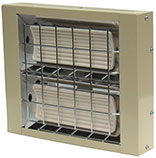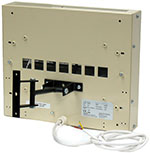
| ||||
W. Tombling Ltd.
Wembley House
Dozens Bank
West Pinchbeck
Spalding
Lincolnshire
PE11 3ND
U.K.


You are here:- home > heater index > radiant heating index > wall mounted radiant heaters > frequently asked questions
Electrical ceramic radiant heaters - frequently asked questions
This page answers the most common questions we are asked about our wall mounted electrical radiant heaters.
Is my building suitable for electrical radiant heaters?
Electric radiant heaters are suitable for use:In buildings that are poorly insulated, drafty, or where doors or loading bays are kept open.See electrical radiant heating for industrial buildings for more details.
For heating specific areas inside larger spaces. I.e. production lines or workstations.
In buildings that are unoccupied for long periods, such as churches, village halls, etc.
Can I use ceramic radiant heaters where flammable vapours are present?
No, radiant heaters operate at high temperatures and there is also the risk of arcing and sparks. Radiant heaters must not be used where hazardous vapours as defined in BS5345 may be present.
How do electrical radiant heaters work?
Electrical radiant heaters work in the same way as the sun. They produce rays that pass through air without heating it, when the rays hit a surface or person; the energy is converted to heat.
Can I install them myself?
The HC1500 and HC3000 can be fitted with a standard 13A plug, which you can
do yourself.
HC1500 and HC3000 wall mounted heaters which are permanently connected to an electricity
supply (i.e. not fitted with a 13A plug), must be installed by a qualified electrician.
The HC4500 cannot be used with a 13A plug. It must be installed by a qualified electrician using high temperature silicon rubber flexible cable conforming to BS 6500 having a temperature rating of 180C continuous.
Where should they be positioned?
Radiant heaters are most effective when they are installed on opposing walls. See installing ceramic infrared heaters for details.
How are they fixed to the wall or suspended?
All Activair radiant heaters are supplied with a bracket
which allows vertical and horizontal adjustment.
There are also cut-outs in the back of the heaters through which suspension chain or wire can be fed, and
small holes for self tapping screws to attach suspension eyes.
Click on the picture opposite for more details.
Can they be mounted overhead and pointed straight down at the floor?
No, ceramic radiant heaters must always be mounted at an angle to the floor. If they are pointed straight down the heater will overheat and fail.
If you need to mount a heater parallel to the floor use quartz halogen infra red heaters instead.
How much heat do electrical radiant heaters produce?
Unlike warm air heaters, which heat the air, that in turn heats surrounding surfaces. The energy from a radiant heater directly heats the surface it is pointed at, so for any given size of heater they feel much warmer.
How many of your electrical radiant heaters do I need?
For manual calculations see calculating radiant heat load, or use our on-line calculator.
You make 3 sizes of radiant heater, which is most suitable for me?
The HC3000 is our most popular model - it offers the best balance between heat output and cost, and is the biggest model which can be fitted with a 13A plug for temporary or DIY installation.
How critical are the recommended mounting heights?
Try to mount the electrical radiant heaters as closely as possible to the heights given. Mounting them higher reduces the watts/square metre decreasing the heating effect. Mounting them lower increases the heating effect, which can cause overheating.
Are there any mounting restrictions?
The casings of our electrical radiant heaters do get hot. It is important the minimum air gaps are adhered to.Nothing should be placed within 1.5 to 2 metres of the front of the heater, and it should not be pointed directly at combustible surfaces.
What is the difference between 'zone' and 'spot' heating?
Zone heating refers to heating different parts (zones) of an area to different levels. For instance extra heat may be used around loading bays.Spot heating is used for drying, curing or de-icing surfaces. See installing ceramic infrared heaters for more details.
Can I use your electrical radiant heaters for 'spot heating'?
Yes, use the on-line calculator to determine the size of electrical radiant heater required, and then multiply it by 2 to 3 times.
What do electrical radiant heaters cost to run?
Multiply the size of electrical radiant heaters (in Kw) by the cost of one unit of electricity (from your electricity bill) this will give you the running cost for one hour.
Can I use your electrical radiant heaters in food preparation areas?
Yes, because they don't contain glass, and the ceramic emitters are shatterproof, there is no risk of food contamination.Because electrical radiant heaters do not dry the air, they are particularly suited to packhouses, production lines, fruit grading lines, etc. to provide workers with comfortable working conditions while minimising deterioration of the produce.
Why does my ceramic heater trip the RCD protecting it
If your installation is protected by an RCD which trips when the heater is switched on, this may be caused by a build up of moisture in the ceramic emitter caused by storage or long periods of non use in a damp environment.
This should not be regarded as a fault, and is easily rectified by running the heater without an RCD until the emitter drys out.
As a preventitive measure run the heater occasionally during periods when the heater will not be used for some time.
When installing ceramic heaters it is good practice, to distibute them over several circuits each with it's own RCD.
My new electrical radiant heater makes popping/cracking/hissing noises, is this normal?
Popping and crackling is caused by expansion as the heater warms up; it will stop after a few minutes. The noise stops completely after the heater has been used for a few days.
If the emitter has become damp you may notice a hissing noise for a few minutes while it drys out (it it's very wet you may also see steam coming off the emitter), this is nothing to worry about and will normally stop after a few minutes.
Can I use ceramic heaters where it's damp?
When they are not working ceramic emitters do absorb moisture, however once they are turned on it is quickly driven out and has no long lasting deterimental effects.
However, as mentioned above if you have earth leakage protection (i.e. RCD's) you may get some nuisence tripping, in which case we suggest you consider our outdoor infra red heaters instead.
You are here:- home > heater index > radiant heating index > wall mounted radiant heater > frequently asked questions
If you found this page useful, please take a moment
to tell a friend or colleague about it.
Copyright © 2004/7, W. Tombling Ltd.
